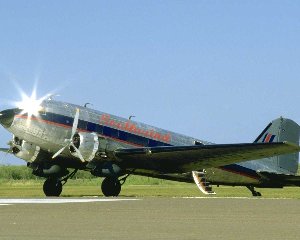The Redoubtable DC-3
Today, we ride the first modern passenger airplane. The University of Houston's College of Engineering presents this series about the machines that make our civilization run, and the people whose ingenuity created them.
Lost Horizon was one of my first movies. Do you remember Ronald Colman stumbling out of an airplane, crash-landed high in the Himalayas, into the mythical city of Shangri-La? I'll never forget it. The year was 1937, and the plane was one of the revolutionary new Douglas models that quite altered air transport in the mid-thirties and that are still being used today -- 50 years later.
The story of the Douglas DC-3 begins with the death of the great football player Knute Rockne in the crash of a Fokker Trimotor in 1931. His death caused a public outcry over the quality of American air passenger service. The leading airliners were then the Fokker Trimotor and its American clone, the Ford Trimotor -- great machines in their day -- made of plywood with a fabric and corrugated-steel covering.
TWA -- then called Western Airlines -- responded by contracting with the Douglas company to build an airplane that could take off fully loaded on just one of its two engines and beat a Ford Trimotor from Santa Monica to Albuquerque. Douglas did just that in 1933 with the experimental DC-1. Then they went into production with the 14-passenger DC-2 version and started service with TWA in 1934.
The DC-2 was a great success, but it was clear that the airplane would have to carry more than 14 people. They contracted with Douglas, whose chief engineer, Bill Littlewood, wrote the specifications for a third and permanent model of this remarkable new plane. The result was the 21-passenger DC-3, which entered service in 1936. By 1941, 80 percent of commercial airplanes in the United States were DC-3s, and they were still the most widely used airliner in 1948.
What the DC-3 did was to combine all-metal stressed-skin construction, variable-pitch propellers, and retractable landing gear into a two-engine, low-wing monoplane that was safe, reliable, and easily maintained. It brought us from the airplane design of the twenties to that of the forties in one step.
Still, these new features weren't unique to the DC-2 and 3. A whole set of flying boats that had most of them also came into being in 1934 -- bigger and with greater range. It isn't clear whether or not they followed Douglas's lead. But it's very clear that the DC-3 is still flying today, and they are not.
1934 has been called the miraculous year of American flight. What really happened was that a lot of good ideas emerged all at once. The DC-3 was the almost perfect combination of these ideas. It was the airplane to take us to Shangri-La.
I'm John Lienhard, at the University of Houston, where we're interested in the way inventive minds work.
(Theme music)
Allen, F., The Letter that Changed the Way We Fly. American Heritage of Invention & Technology, Fall 1998, pp. 6-13.
This episode has been revised as Episode 1409.

(Clipart)
The Redoubtable DC-3